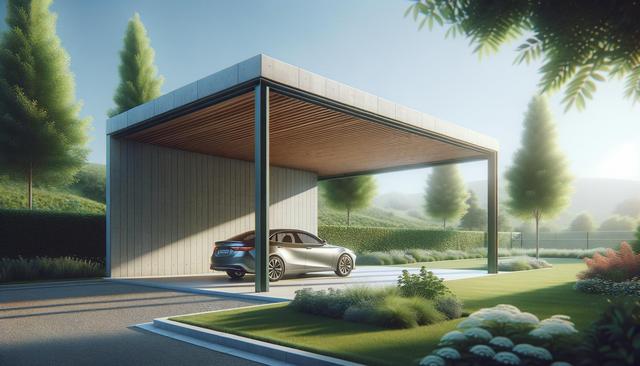Understanding Metal Carport Kits
Metal carport kits are pre-engineered structures designed to offer shelter for vehicles, boats, RVs, or even outdoor tools and supplies. Unlike traditional garages, these kits are often simpler to install and significantly more affordable. They are typically made from galvanized steel or aluminum, which ensures resilience against weather conditions such as rain, snow, and intense sun exposure. These kits come in various sizes and configurations, allowing users to choose the most suitable option based on their specific needs and space availability. Because they are modular, they also offer a degree of flexibility in terms of customization.
Many homeowners and property managers opt for metal carport kits due to their long-term durability and ease of maintenance. Unlike wooden structures, metal carports do not rot, warp, or attract pests. This makes them an attractive choice for those who want a reliable solution without the need for frequent upkeep. Additionally, the protective coating used on most metal carports resists rust and corrosion, extending the life of the structure even in humid or coastal environments.
Benefits of Choosing a Metal Carport
One of the main advantages of metal carports is their affordability compared to building a full garage. This cost-efficiency makes them particularly appealing for families or small businesses looking to protect vehicles or equipment without undertaking a major construction project. Other notable benefits include:
- Quick and easy installation that often requires minimal tools
- Portability, allowing relocation if needed
- Low maintenance requirements
- Versatile usage for more than just vehicle storage—think patios, workshops, or outdoor events
In regions prone to extreme weather, a metal carport provides a reliable barrier against hail, UV rays, and heavy rain. For users who prioritize sustainability, many carport kits are also recyclable, making them an environmentally responsible choice.
Choosing the Right Kit for Your Needs
Selecting the right metal carport kit involves considering several factors, including size, roof style, material type, and anchoring options. For example, a single-car carport may be sufficient for most residential users, while a multi-vehicle unit may be more appropriate for families with several cars or a small business with a fleet. Roof styles—such as regular, boxed-eave, or vertical—affect both aesthetics and functionality, particularly in areas with heavy snow or rainfall.
It’s also essential to check local building codes and permit requirements before setting up a carport. Some municipalities may have guidelines related to height, placement, and design. Additionally, consider the ground surface where the carport will be installed. Common anchoring options include:
- Concrete anchors for paved or slab areas
- Mobile home anchors for soil or gravel foundations
- Rebar or auger anchors for temporary setups
By evaluating these elements, you can ensure that the carport you choose meets both your practical needs and any local regulatory standards.
Installation and Maintenance Tips
Installing a metal carport kit is typically a straightforward process, especially when the kit includes pre-drilled components and clear instructions. However, depending on the size and complexity of the structure, you may need an extra set of hands or even professional assistance. Proper installation is critical to the longevity and stability of your carport, particularly in areas with high winds or seasonal storms.
Basic steps for installation generally include:
- Preparing the ground and ensuring a level surface
- Assembling the frame and securing it with anchors
- Attaching roofing panels and any side walls or optional features
Once installed, maintaining a metal carport is relatively simple. Periodic checks for loose bolts, rust spots, or debris buildup on the roof will help preserve its condition. Washing the surfaces with mild soap and water can also keep it looking clean and prevent corrosion. For added protection, some users apply a weatherproof sealant every few years.
Additional Uses and Customization Options
While primarily used for vehicle storage, metal carports are incredibly versatile. They can be customized to serve a variety of functions, from outdoor workspaces to picnic shelters or even boat covers. Add-on features such as side panels, gable ends, or enclosed walls can enhance functionality and protection.
Some popular uses beyond vehicle storage include:
- Covering garden equipment or firewood stacks
- Creating shaded outdoor seating or play areas
- Storing bikes, trailers, or recreational gear
- Serving as a temporary shelter for events or markets
Customizing your carport can also involve selecting specific colors, roof styles, or decorative trims to match your home or landscape. Many suppliers offer online design tools that allow you to visualize different configurations before making a purchase, helping you choose a kit that aligns with both your practical and aesthetic preferences.
Conclusion: A Smart Investment for Practical Protection
Affordable metal carport kits present a practical solution for anyone looking to shield their vehicles and belongings from the elements without committing to a permanent or expensive structure. Whether for residential use, small business needs, or multi-purpose outdoor coverage, these kits provide flexibility, reliability, and ease of use. With various styles, sizes, and customization options available, they cater to a wide range of needs and environments. Investing in a metal carport is not only a cost-effective decision but also one that adds value and convenience to your property over time.




Leave a Reply